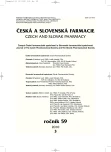Pyrazinecarboxylic acid derivatives as effective abiotic elicitors of isoflavonoids production
Authors:
L. Tůmová 1; J. Tůma 2
; M. Doležal 3; B. Danielová 1
Authors‘ workplace:
Univerzita Karlova v Praze, Farmaceutická fakulta v Hradci Králové, Katedra farmakognosie
1; Univerzita Hradec Králové, Pedagogická fakulta, Katedra biologie
2; Univerzita Karlova v Praze, Farmaceutická fakulta v Hradci Králové, Katedra farmaceutické chemie a analýzy léčiv
3
Published in:
Čes. slov. Farm., 2010; 59, 117-122
Category:
Original Articles
Overview
Genista tinctoria (Dyer’s Greenweed) is a plant containing isoflavonoids, which rank among important estrogens. The in vitro culture of this plant produces more isoflavonoids than the parent plant. The paper aimed to even more increase the production of these substances in the callus culture by the action of abiotic elicitors, in this case pyrazinecarboxylic acid derivatives. A more suitable elicitor for the production of isoflavonoids proved to be substance A (N-(3-iodo-4-methylphenyl)pyrazine-2-carboxamide), even though the absolute maximum of genistin production was achieved by a 12-hour action of substance B (5-terc-butyl-6-chloro-N-(3-iodo-4-methylphenyl)pyrazine-2-carboxamide) in a concentration of 2.33 . 10-3 mol/l (57 times versus control). By means of elicitation using substance B, more balanced results were achieved in an increased production of isoflavonoids in the cross-section of the individual withdrawal times and concentrations.
Key words:
Genista tinctoria – isoflavonoids – callus culture – pyrazinecarboxylic acid derivatives
Sources
1. Sikyta, B., Dušek J.: Biotechnologie pro farmaceuty. 2. vyd. Praha: Karolinum, 2001; 75–84.
2. Kašparová, M., Siatka, T., Dušek, J.: Vliv kyseliny jasmonové na produkci anthracenových derivátů v kultuře Rheum palmatum L. in vitro. Čes. slov. Farm., 2003; 52 (3), 148–151.
3. Kašparová, M., Siatka, T.: Vliv chitosanu na produkci anthracenových derivátů v tkáňové kultuře Rheum palmatum L. Čes. slov. Farm., 2001; 50, 249–253.
4. Tůmová, L., Blažková, R.: Vliv tvorby flavonoidů v kuluře Ononis arvensis L. in vitro působením CrCl3. Čes. slov. Farm., 2002; 51, 44-46.
5. Doležal, M.: Biologicky aktivní pyraziny přírodního a syntetického původu. Chem. listy 2006; 100, 959–966.
6. Doležal, M., Tůmová, L., Kešetovičová, D., Tůma, J., Kráľová, K.: Substituted N-Phenylpyrazine-2-carboxamides. Their Synthesis and Evaluation as Herbicides and Abiotic Elicitors. Molecules, 2007; 12, 2589–2598.
7. Doležal, M., Čmedlová, P., Palek, L., Vinšová, J., Kuneš, J., Buchta, V., Jampílek, J., Kráľová, K.: Synthesis and antimycobacterial evaluation of substituted pyrazincarboxamides. Eur. J. Med. Chem., 2008; 45, 1105–1113.
8. Tůmová, L., Gallová, K., Řimáková, J., Doležal, M., Tůma, J.: The effect of substituted amides of pyrazine-2-carboxylic acids on flavonolignan production in Silybum marianum culture in vitro. Acta Physiol. Plant., 2005; 27, 357–362.
9. Łuczkiewicz, M., Piotrowski, A.: Two-Stage system for Microprapagation of Several Genista Plants Producing Large Amounts of Phytoestrogens. Z. Naturforsch. 2005; 60c, 557–566.
10. Hubík, J., Dušek, J., Spilková, J., Šícha, J.: Obecná farmakognosie II. Praha: SNP 1989, 175.
11. Łuczkiewicz, M., Głód, D.: Morphogenesis-dependent accumulation of phytoestrogenes in Genista tinctoria in vitro cultures. Plant Sci., 2005; 168, 967–979.
12. Łuczkiewicz, M., Głód, D.: Callus cultures of Genista plants-in vitro material producing high amounts of isoflavones of phytoestrogenic activity. Plant Sci., 2003; 165, 1101–1108.
13. Ososki, A. L., Kennelly, E. J.: Phytoestrogens: a Review of the Present State of Research. Phytother. Res., 2003; 17, 845–869.
14. Button, B. J., Patel, N.: Phytoestrogens for Osteoporosis. Clinic. Rev. in Bone and Mineral Metabolism, 2004; 2, 341–356.
15. Schenk, R. U., Hildebrandt, A. C.: Medium and techniques for induction of growth of monocotyledonous and dicotyledonous plant cell cultures. Canad. J. Bot., 1972; 50, 199–204.
16. Kašparová, M., Siatka T.: Produkce anthracenových derivátů elicitovanou tkáňovou kulturou Rheum palmatum L. Čes. slov. Farm., 1999; 48, 256–261.
17. Kašparová, M., Dušek, J.: Vliv biotické elicitace na produkci anthraglykosidů tkáňovou kulturou Rheum palmatum L. Čes. slov. Farm., 1999; 48, 132–135.
18. Tůmová, L., Tůma, J., Doležal, M., Megušar, K.: Substituted pyrazinecarboxamides as abiotie elicitors of the flavonolignan production in Silybum marianum culture in vitro. Molecules, 2010; 15, 331–340.
19. deRijke, E., Joshi, H. C., Sanderse, H. R., Ariese, F., Brinkman, U. A. Th., Gooijer, C.: Natively fluorescent isoflavones exhibiting anomalous Stokes’shifts. Anal. Chim. Acta, 2002; 468, 3–11.
Labels
Pharmacy Clinical pharmacologyArticle was published in
Czech and Slovak Pharmacy

2010 Issue 3
Most read in this issue
- Analytical methods for the determination of selected psychopharmaceuticals
- A comparison of the retardation effects of natural matrix-forming polymers and the synthetic polymers Kollicoat SR and Eudragit NE
- Influence of the kind of polymer on chlorhexidine liberation from hydrogel
- Pyrazinecarboxylic acid derivatives as effective abiotic elicitors of isoflavonoids production
